The following transport ships were used to convey the troops of the 5th/22nd, the 22nd Battalion plus other key elements of the AIF during the First World War. Although just a sub-section of the ships used by the Australians in the war they are nevertheless representative of the types of vessels used. The transport ships are listed in chronological order, helping to tell the story of an Australian Infantry battalion during the First World War from their departure from Australia, arrival in Egypt, Gallipoli, and France, and then for the return to Australia at the end of the war. For the full list of transports used by the 22nd Battalion, see the bottom of this section, plus for a more comprehensive list of the dozens of transports used as troop ships by the AIF during the war, please use the following links:
Flotilla Australia Digger History Australian Light Horse Studies Centre
 HMAT Orvieto (A3) – carried AIF Commanding Officer in the first convoy, November 1914
HMAT Orvieto (A3) – carried AIF Commanding Officer in the first convoy, November 1914
Orient Line passenger steamship built 1909
12,130 tons, length 163m
After being refitted as a troop carrier, the Orvieto sailed as part of the first convoy of ships carrying troops from Australia and New Zealand for Europe during the First World War, departing Albany Western Australia on 1st November 1914. On board was Major General Bridges, Commander of the AIF, and his staff, plus the 5th Infantry Battalion. Also on board was the official war correspondent C.E.W. Bean.
On the journey the convoy stopped at Colombo to re-fuel, and the Orvieto took on board a number of prisoners from the German cruiser SMS Emden that had been engaged and put out of action by HMAS Sydney, a light cruiser of the Royal Australian Navy. She then proceeded to Egypt via Aden where the troops (and prisoners) disembarked.
On 8th March 1915 she was commissioned under the British Admiralty and performed mine laying duties along the east coast of Britain in the North Sea. In July 1916 she was placed on the Northern Patrol and over a six month period intercepted 30 foreign merchantmen which were sent into British ports for searching. In Spring 1918 she was placed on Atlantic convoy duties, and at the end of the war she was returned to the Orient Line. On 1st November 1919 she sailed for Brisbane and remained on the mail run until she was decommissioned in 1930.
Click on link for historical footage of the Orvieto departing Melbourne in 1914.
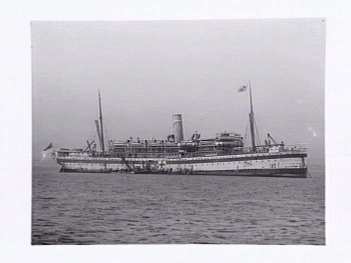 HMAT Kyarra (A55) – carried 1st & 2nd Australian General Hospital from Australia, November 1914; sunk in English Channel in May 1918
HMAT Kyarra (A55) – carried 1st & 2nd Australian General Hospital from Australia, November 1914; sunk in English Channel in May 1918
Australian United Steam Navigation Co.Ltd built in 1903
6,953 tons, length 415ft
The Fremantle registered Kyarra was a twin-masted schooner-rigged steamer built in 1903 by the W. Denny Brothers ship builders, Dumbarton on the river Clyde, Scotland. The name Kyarra was taken from the aboriginal for possum fur. On 6 November 1914 she was requisitioned and converted into a hospital ship (HMAT A.55 Kyarra) for the purpose of transporting Australian medical units to Egypt. The 1st and 2nd Australian General Hospital medical staff sailed from Brisbane on the 21st November 1914 to Sydney where it set course on 28th November for Egypt. The hull was painted white with a large red cross on the side.
In March 1915, Kyarra was converted into a troop transport. In May 1918 the Kyarra was on route from Tilbury, London to Sydney. She was carrying 2600 tons general and Australian mails, plus hospital supplies and medical staff and heading first for Devonport to embark 1,000 Australian wounded. She was armed with a quick-firing gun mounted on her stern as a defence against U-boats. In the early morning of 26th May 1918, the Kyarra had cleared the Isle of Wight and was moving fast through calm seas around Anvil Point just off Swanage, Dorset. Unknown to Captain William Smith German submarine captain Oberleutnant Johann Lohs was watching him through the periscope of UB-57. The Kyarra was struck by a torpedo portside amidships, sinking and killing 6 of her 126 crew members.
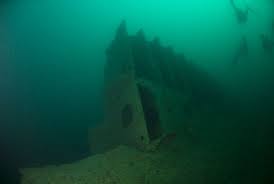 The wreck was not discovered until the late 1960’s. Today the Kyarra is one of the most well-known and popular wrecks for divers in southern England. The holds still contain perfume, champagne, stout, red wine, and vinegar bottles. Sealing wax, medical supplies, dentists porcelain teeth, collar studs, gold, silver and brass watches, pipes, fountain pens, lead printing blocks, printing paper, copper pipe, dinner sets, comic books, silk, fabric, brass picture frames and hockey sticks have all been found. Click on picture for U-tube dive video footage, courtesy of Swanage Boat Charters Ltd.
The wreck was not discovered until the late 1960’s. Today the Kyarra is one of the most well-known and popular wrecks for divers in southern England. The holds still contain perfume, champagne, stout, red wine, and vinegar bottles. Sealing wax, medical supplies, dentists porcelain teeth, collar studs, gold, silver and brass watches, pipes, fountain pens, lead printing blocks, printing paper, copper pipe, dinner sets, comic books, silk, fabric, brass picture frames and hockey sticks have all been found. Click on picture for U-tube dive video footage, courtesy of Swanage Boat Charters Ltd.
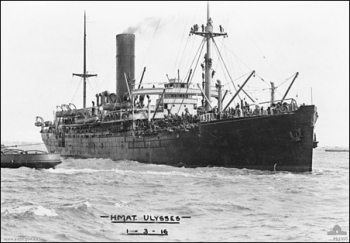 HMAT Ulysses (A38) – transported the 22nd Battalion from Australia to Egypt, May 1915; transported the 6th/22nd in October 1915
HMAT Ulysses (A38) – transported the 22nd Battalion from Australia to Egypt, May 1915; transported the 6th/22nd in October 1915
Owned by China Mutual SN Co. London
14,499 tons, average cruise speed of 14 knots
Launched in 1913, the Ulysses was the largest ship to serve as a troop carrier, and was leased by the Commonwealth until 15th August 1917. On 8th May 1915 she set sail from Melbourne with the first contingents of the 21st and 22nd Battalions and 6th Brigade Headquarters. On a subsequent voyage on 27th October 1915 she transported the 6th reinforcements 22nd Battalion to Egypt. 2375 Pte Smith, 2464 Pte Bolger and 2469 Pte Edwards of the 5th/22nd returned to Australia on the Ulysses.
The Ulysses also sailed between Australia and England during the Second World War, again ferrying Australian troops and airmen to the front. The Ulysses was torpedoed by an unknown German submarine in 1942 and sunk off Florida after apparently disobeying an order that would have led her through safer waters.
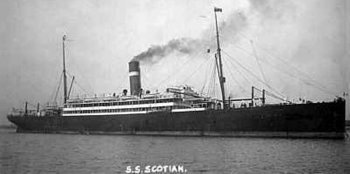 HMT Scotian – transported the 22nd Battalion from Egypt to Lemnos, August 1915
HMT Scotian – transported the 22nd Battalion from Egypt to Lemnos, August 1915
Built by Harland & Wolff, Belfast and launched in May 1898
The Scotian originally sailed the North Atlantic routes from Europe to North America and was brought into war service in September 1914 to help augment the ships of the Royal Fleet Auxiliary, first bringing troops of the Canadian Expeditionary Force to England. In August 1915 the Scotian was boarded by the 22nd Battalion at Alexandria, en-route to the staging island of Lemnos before heading to Gallipoli. The Scotian was finally scrapped in 1927.
 HMT Southland – carried the 2nd Divison HQ from Egypt to Lemnos, September 1915 and torpedoed by U-boat
HMT Southland – carried the 2nd Divison HQ from Egypt to Lemnos, September 1915 and torpedoed by U-boat
Red Star ocean liner launched July 1900 as SS Vaderland
11,899 tons, length 171m, speed 15 knots
HMT Southland initially operated as a liner between Antwerp and New York under British registry, but was re-registered in Antwerp in 1903. After the beginning of the First World War, Vaderland was re-registered in Liverpool and converted to a troopship, ferrying troops of the Canadian Expeditionary Force from Halifax to Liverpool. While under the operation of White Star–Dominion in 1915, she was renamed Southland to avoid the German-sounding Vaderland.
The Southland was later used in the Mediterranean to carry troops of the 6th Essex regiment and two companies of 1/7th Essex from Devonport to Gallipoli from 4th July 1915 to 11th August 1915, and later from Alexandria, the Australian 2nd Division headquarters with the 21st Battalion. During its sail from Egypt to Gallipoli on the 2nd September 1915 at 9:45am it was torpedoed by the German submarine UB-14 30 nautical miles (56 km) from Lemnos in the Aegean Sea. The ship did not sink immediately, and was eventually beached on Lemnos, and all but 40 of 1,400 men were able to leave in lifeboats and were picked up by other transports. Fourteen persons were killed by the explosion and twenty two were drowned including AIF 6th Brigade Commanding Officer Brigadier General Linton.
The Southland was repaired and returned to White Star–Dominion for Liverpool–Quebec–Montreal service in August 1916, but on 4th June 1917 was torpedoed and sunk by the German submarine SM U-70 while 140 nautical miles (260 km) northwest of Tory Island off the Irish coast.
 HMT Osmanieh – transported the 22nd Battalion from Lemnos to Anzac, Gallipoli, September 1915; sunk in December 1917 off Alexandria
HMT Osmanieh – transported the 22nd Battalion from Lemnos to Anzac, Gallipoli, September 1915; sunk in December 1917 off Alexandria
Built by Swan, Hunter & Wigham Richardson, Ltd., Newcastle in 1906 and owned by the Kedivial Co.,
4,041 tons, length 110m, speed 17 knots
The Osmanieh was hired by the Royal Navy and used as a troop transport. In September 1915 she was used to transport the 22nd Battalion from the Greek island of Lemnos to Anzac Cove on the Gallipoli Peninsula. On 31st December 1917, having sailed from Southampton with troops and medical personnel on board, the Osmanieh was sunk by a mine from the German submarine UC-34 at the entrance to the Alexandria Harbour. 198 persons were killed, including the Captain.
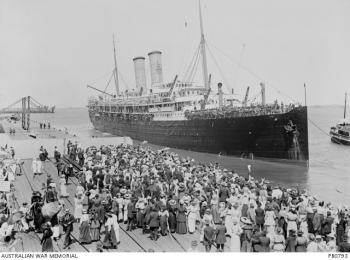 RMS Osterley – transported the 5th/22nd from Melbourne to Egypt, September 1915
RMS Osterley – transported the 5th/22nd from Melbourne to Egypt, September 1915
Owned by the P & O SN Co, London
12,129 tons with an average cruise speed of 18 knots
The RMS Osterley was built by the London & Glasgow Shipbuilding Co on the Clyde in 1909. She was operated by the Orient Steamship Navigation Company on the United Kingdom to Australia service. During the First World War the Osterley was used as a troop ship by the AIF, and on 29th September 1915 conveyed the 5th/22nd Battalion to Egypt. Avoiding the German cruiser ‘Emden’ twice in 1914, the Osterley came through the war unscathed and was returned to commercial service in January 1919. During her time in operation the Osterley would run 59 voyages from the United Kingdom to Australia before being decommissioned and broken up in 1930.
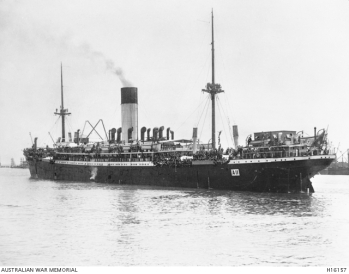 HMAT Ascanius (A11) – transported the 22nd Battalion from Lemnos to Egypt, January 1916; transported 19th/22nd in May 1917
HMAT Ascanius (A11) – transported the 22nd Battalion from Lemnos to Egypt, January 1916; transported 19th/22nd in May 1917
Built in 1910 by Workman, Clark in Belfast
10,048 tons, length 150.3 metres, speed 14 knots
The Ascanius was originally a passenger / refrigerated cargo steamship owned by the Ocean Steamship Company, Liverpool. She was leased by the Commonwealth and was part of the first convoy transporting the 3rd Infantry Brigade to Egypt in November 1914.
In January 1916 and following the recent evacuation from Gallipoli, the Ascanius picked up and transported the 22nd Battalion that had were waiting in Mudros Harbour, Lemnos, bound for Egypt where the AIF was re-grouping. In all she completed nine transport trips from Australia until her final voyage on 11th May 1917, which also included the 19th reinforcements of the 22nd Battalion.
After the war she resumed her refrigerated meat service, sailing between Liverpool and Australia. The Ascanius was re-employed as a troopship in the Second World War. Although torpedoed she made it to port and resumed service to Australia in 1946. The Ascanius was sold in 1949 and renamed the San Giovannio, and was finally scrapped in Italy in July 1952.
 Llandovery Castle – transported the 22nd Battalion from Egypt to France, March 1916; sunk as Hospital Ship by German U-boat in June 1918
Llandovery Castle – transported the 22nd Battalion from Egypt to France, March 1916; sunk as Hospital Ship by German U-boat in June 1918
Built in 1914 in Glasgow for the Union-Castle Line
10,639 tons; speed 15 knots
Launched in September 1913 and completed in January 1914, the Llandovery Castle initially sailed between London and East Africa, then London and West Africa. She was requisitioned in 1916 and was used to transport the 22nd Battalion from Alexandria to Marseille in March 1916 as the AIF, and with the 2nd Division at the fore, moved to France for the fighting on the Western Front. She was commissioned as a hospital ship on 26th July 1916, and assigned to the Canadian Forces, equipped with 622 beds and a medical staff of 102.
One of the more controversial events during the Great War was the sinking of the Canadian Hospital Ship Llandovery Castle by a German submarine, U-86, on 27th June, 1918. The ship was returning to England after having brought Canadian casualties back to Halifax, Nova Scotia. Being a Hospital Ship, it was clearly identified as such with a brightly illuminated Red Cross, was unarmed and running with full lights. On board, the crew consisted of one hundred and sixty-four men, eighty officers and men of the Canadian Medical Corps, and fourteen nurses, a total of two hundred and fifty-eight persons.
The Llandovery Castle was struck by torpedo at night, and despite difficulty the crew and medical staff were able to get into a number of lifeboats before she sank, and they started to pick up survivors in the water. The submarine came up and interrupted the recovery and went alongside the Captain’s lifeboat. The U-boat commander took Captain Sylvester on board and started questioning him along with a Canadian Medical Officer in the belief that the ship had eight American Flying Officers on board. This was denied and the Captain and Medical Officer were allowed back into the lifeboat. However with most of the U-boat crew now below deck in preparation for diving, orders were given to open fire on the lifeboats to destroy the evidence of the torpedoing. Only one lifeboat survived the attack. It was picked up by the destroyer Lysander on the morning of 29 June, 36 hours after the attack. Just twenty four people survived the attack on the lifeboats, including six members of the Canadian Army Medical Corps. All 14 Nursing Sisters on board lost their lives. For the Canadians this was the most significant naval disaster in the war, and given the status of the ship and the medical crew on board was met with outrage. After the war, the British initiated a War Crimes trial against the officers of U-86. The commander, Helmut Patzig could not be found and was never brought to trial. The two other officers, Ludwig Dithmar and John Boldt were tried and convicted. The men were sentenced to 4 years of hard labour, but escaped while underway to the prison. It is unclear if they were ever recaptured.
 SS Castalia – transported many of the homeward bound 22nd Battalion (including 13 men of the 5th/22nd) returning to Australia April 1919
SS Castalia – transported many of the homeward bound 22nd Battalion (including 13 men of the 5th/22nd) returning to Australia April 1919
Built in 1906 by Barclay Curle & Co. Ltd of Glasgow
6388 tons, 441 feet long
Operated by the Anchor Line, the SS Castalia was a passenger and general cargo vessel, accommodating 102 cabin class passengers. On 13th April 1919 she sailed from Devonport with soldiers of the AIF returning to Australia. On board were thirteen members of the 5th/22nd that had sailed together from Melbourne on the Osterley four years previous. This group of thirteen represented the most number of 5th/22nd returning home to Australia together at the same time. Also on board was Lieutenant LW Harricks, Adjutant of the 22nd Battalion, and there are plenty of his personal photographs and other memorabilia from the journey home in his private collection provided by Jennie Marshall.
The Castalia survived both wars and was sold to an Italian line in 1949 running a service to Central America. She was subsequently renamed the Marengo and then Urania II in 1950 before being scrapped in Italy in December 1953.
 SS Mahana – the ‘bride boat’ returning soldiers and wives to Australia and New Zealand, 1919/20
SS Mahana – the ‘bride boat’ returning soldiers and wives to Australia and New Zealand, 1919/20
Built in 1917 by Workman Clark, Belfast.
11,796 tons, speed 13 knots
The S.S. Mahana was commonly referred to at the time as the “Bride Boat”, since many of its passengers were newlywed female post-war emigrants and their partners. Minnie Taylor from Twickenham was one such bride having just married 2394 Pte Stephens of the 22nd Battalion. Subsequent sailings in 1920 would take young English women to New Zealand in search of a husband.
The Mahana, launched on 11th January 1917, was taken up under the Liner Requisition Scheme in the April, three months before she was completed. She had the capacity to carry 1,500 passengers, but her 3rd Class accommodation for 450 passengers was removed in 1926 and she was converted for use as a cargo ship. During the War the Ministry of War Transport didn’t take up Mahana and therefore her war years were totally uneventful. In 1949 she was chartered by the Ministry of Food for use as a cold storage unit before being scrapped at Dalmuir in 1953.


 FIRST WORLD WAR TIMELINE
FIRST WORLD WAR TIMELINE